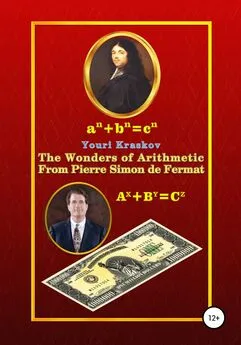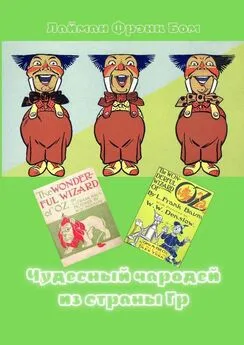Youri Kraskov - The Wonders of Arithmetic from Pierre Simon de Fermat
- Название:The Wonders of Arithmetic from Pierre Simon de Fermat
- Автор:
- Жанр:
- Издательство:неизвестно
- Год:2021
- ISBN:978-5-532-98629-9
- Рейтинг:
- Избранное:Добавить в избранное
-
Отзывы:
-
Ваша оценка:
Youri Kraskov - The Wonders of Arithmetic from Pierre Simon de Fermat краткое содержание
The Wonders of Arithmetic from Pierre Simon de Fermat - читать онлайн бесплатно ознакомительный отрывок
Интервал:
Закладка:
1. Filling: a+1>a
2. The neutrality of the unit: a×1=a:1=a
3. Commutativity: a+b=b+a; ab=ba
4. Associativity: (a+b)+c=a+(b+c); (ab)c=a(bc)
5. Distributivity: (a+b)c=ac+bc
6. Conjugation: a=c → a±b=b±c; ab=bc; a:b=c:b; ab=cb; log ba=log bc
These properties have long been known as the basics of primary school and so far, they have been perceived as elementary and obvious. The lack of a proper understanding of the origin of these properties from the essence the notion of number has led to the destruction of science as a holistic system of knowledge, which must now be rebuilt beginning from the basics and preserving herewith everything valuable that remains from real science.
The presented above axiomatics proceeds from the definition the essence the notion of number and therefore represents a single whole. However, this is not enough to protect science from another misfortune i.e. so that in the process of development it does not drown in the ocean of its own researches or does not get entangled in the complex interweaving of a great plurality of different ideas.
In this sense, it must be very clearly understood that axioms are not statements accepted without proof. Unlike theorems, they are only statements and limitations synthesized from the experience of computing, without of which they simply cannot be dispensed. Another meaning is in the basic theorems, which are close to axioms, but provable. One of them is the Basic or Fundamental theorem of arithmetic. This is such an important theorem that its proof must be as reliable as possible, otherwise the consequences may be unpredictable.
Pic. 33. Initial Numbers Pyramids

3.3. The Basic Theorem of Arithmetic
3.3.1. Mistakes of the Greats and the Fermat's Letter-Testament
The earliest known version of the theorem is given in the Euclid's "Elements" Book IX, Proposition 14.
If a number be the least that is measured by prime numbers, it will not be measured by any other prime number except those originally measuring it .
The explain is following: “Let the number A be the least measured by the prime numbers B, C, D. I say that A will not be measured by any other prime number except B, C, D”. The proof of this theorem looks convincing only at first glance and this visibility of solidity is strengthened by a chain of references: IX-14 → VII-30 → VII-20 → VII-4 → VII-2.
However, an elementary and even very gross mistake was made here. Its essence is as follows:
Let A=BCD where the numbers B, C, D are primes. If we now assume the existence of a prime E different from B, C, D and such that A=EI then we conclude that in this case A=BCD is not divisible by E.
This last statement is not true because the theorem has not yet been proven and it doesn’t exclude for example, BCD=EFGH where E, F, G, H are primes other than B, C, D. Then
A:E=BCD:E=EFGH:E=FGH
i.e. in this case it becomes possible that the number A can be divided by the number E and then the proof of the theorem is based on an argument that has not yet been proven, therefore, the final conclusion is wrong. The same error can take place also in other theorems using decomposition of integers into prime factors. Apparently, due to the archaic vocabulary Euclid's “Elements” even such a great scientist as Euler did not pay due attention to this theorem, otherwise, he would hardly have begun to use “complex numbers” in practice that are not subordinate to it.
The same story happened with Gauss who also did not notice this theorem in the Euclid's "Elements", but nevertheless, formulated it when a need arose. The formulation and proof of Gauss are follows:
“ Each compose number can be decomposed into prime factors in a one only way.
If we assume that a composite number A equal to a αb βc γ…, where a, b, c, … denote different primes, can be decomposed into prime factors in another way, then it is first of all clear that in this second system of factors, there cannot be other primes except a, b, c, …, because the number A composed of these latter cannot be divisible by any other prime number ” [11, 25].
This is an almost exact repeating of erroneous argument in the Euclid's proof. But if this theorem is not proven, then the whole foundation of science built on natural numbers collapses and all the consequences of the definitions and axioms lose their significance. And what to do now? If such giants of science as Euclid and Gauss could not cope with the proof of this theorem, then what we sinners can to do. But yet there is a way out and it is indicated in one amazing document called "Fermat's Letter-Testament".
This letter was sent by Fermat in August 1659 to his longtime friend and former colleague in the Parliament of Toulouse the royal librarian Pierre de Carcavy from whom he was received by the famous French scientist Christian Huygens who was the first to head the French Academy of Sciences created in 1666. Here we give only some excerpts from this Fermat's letter, which are of particular interest to us [9, 36].
“Summary of discoveries in the science about numbers. …
1. Since the usual methods set in the Books are not sufficient to prove very difficult sentences, I finally found a completely special way to solve them. I called this method of proof infinite or indefinite descent. At first, I used it only to prove negative sentences such as: … that there exists no a right triangle in numbers whose area is a square” . See Appendix II for details.
The science about numbers is called here arithmetic and the further content of the letter leaves no doubt about it. Namely with arithmetic not only mathematical, but also all other sciences begin. In arithmetic itself the descent method is one of the fundamental one. The following are examples of problems whose solution without this method is not only very difficult, but sometimes even hardly to be possible. Here we will name only a few of these examples.
" 2. For a long time, I could not apply my method to affirmative sentences because rounds and circuitous ways to achieve the aim are much more difficult than those that served me for negative sentences. Therefore, when I needed to prove that every prime number that is by unit more than multiple of four, consists of two squares, I was in a greatest difficulty. But finally, my thoughts repeated many times shed light that I did not have and the affirmative sentence became possible to interpret with my method using some new principles that needed to be attached to them. This progress in my reasoning for the case of affirmative sentences is as follows: if some prime number that on 1 exceeds the multiplied of 4, does not consist of two squares, then there is another a prime number of the same nature, smaller than this and then a third, also smaller etc. going down until you come to the number 5, which is the smallest from all numbers of this nature. It therefore, cannot consist of two squares, what however, takes place. From this by proof from the contrary we can conclude that all primes of this nature should consist of two squares ”.
This Fermat’s theorem was first proven by Euler in 1760 [6, 38], (see Appendix III), and in the framework of the very complex Gauss' "Deductive Arithmetic" this theorem is proving in one sentence [23]. However, no one succeeded in repeating the proof of Fermat himself.
“… 3. There are infinitely many questions of this kind, but there are others that require new principles for applying the descent method to them … This is the next question that Bachet as he confesses in his commentary on Diophantus, could not prove. On this occasion, Descartes made the same statement in his letters acknowledging that he considers it so difficult that he sees no way to solve it. Each number is a square or consists of two, three or four squares ".
Else earlier, 22 years ago, in October 1636 in a letter to Mersenne Fermat reported on the same problem as about his discovery, but in general form i.e. for any polygonal numbers (for example, triangles, squares, pentagons etc.). Subsequently, he even called this theorem golden one. Consequently, the method of descent was discovered by him at the very beginning of his research on arithmetic. By the time of writing the letter-testament, Fermat already knew from Carcavy that the question of foundation the French Academy of Sciences was practically resolved and he needed only to wait for the building to be completed, so it come true his life's dream to become a professional scientist in the rank of academician. Huygens was commissioned to collect materials for the first academic publications. Fermat proposed for them the method of descent discovered by him and the solution of specific arithmetic tasks on its basis.
However, only few people knew that these tasks were very difficult and Fermat understood that if he would publish their solutions, they would not make any impression at all. He already had such an experience and now he has prepared a real surprise. For those who don't appreciate the value of his solution, he would offer to solve another task. This is the Basic theorem of arithmetic, which is of particular importance for all science since without it the whole theory loses its strength. Fermat found a mistake in the proof of Euclid and came to the conclusion that to prove this theorem without applying the descent method is extremely difficult if at all possible. However, now we can also reveal this secret with the help of our opportunities to look into Fermat’s cache with “heretical writings” and return his lost proof to science in the form of the reconstruction presented below.

3.3.2. The Proof of Fermat
So, to prove the Basic theorem of arithmetic we suppose that there exist equal natural numbers A, B consisting of different prime factors:
A=B (1)
where A=pp 1p 2…p n; B=хx 1x 2…x m; n≥1; m≥1
Due to the equality of the numbers A, B each of them is divided into any of the prime numbers p ior x i. Each of the numbers A, B can consist of any set of prime factors including the same ones, but at the same time there is no one p iequal to x iamong them, otherwise they would be in (1) reduced. Now (1) can be represented as:
pQ=xY (2)
where p, x are the minimal primes among p i, x i; Q=A/p; Y=B/x .
Since the factors p and x are different, we agree that p>x; x=p–δ 1then
pQ=(p – δ 1)(Q+δ 2) (3)
where δ 1=p–x; δ 2=Y–Q
From (3) it follows that Qδ 1=(p – δ 1)δ 2or
Qδ 1=xδ 2(4)
Equation (4) is a direct consequence of assumption (1). The right side of this equation explicitly contains the prime factor x. However, on the left side of equation (4) the number δ 1cannot contain the factor x because δ 1= p – x is not divisible by x due to p is a prime. The number Q also does not contain the factor x because by our assumption it consists of factors p iamong which there is not a single equal to x. Thus, there is a factor x on the right in equation (4), but not on the left. Nevertheless, there is no reason to argue that this is impossible because we initially assume the existence of equal numbers with different prime factors.
Then it remains only to admit that if there exist natural numbers A = B composed of different prime factors, then it is necessary that in this case there exist another natural number A 1=Qδ 1and B 1=xδ 2; also equal to each other and made up of different prime factors. Given that δ 1=(p–x)
Читать дальшеИнтервал:
Закладка:



![О Генри - С высоты козел [From the Cabby's Seat]](/books/1083418/o-genri-s-vysoty-kozel-from-the-cabby-s-seat.webp)






